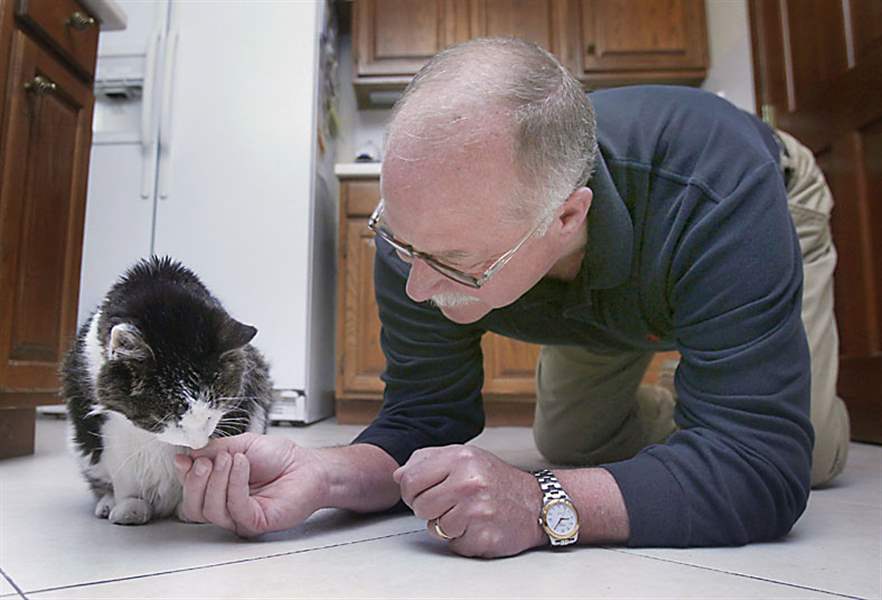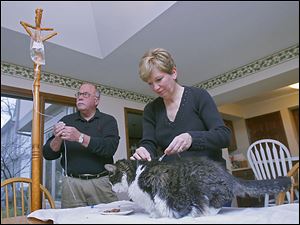
CRITTER CARE
Kidney treatment may delay pet’s death
Injection of fluids easy to do at home
3/21/2013
Joe Reynolds on occasion will get down on his hands and knees to feed Kit Kat, who is suffering from kidney disease but is being treated with fluids.
The Blade/Lori King
Buy This Image

Toledoans Joe and Anne Reynolds administer medicated fluids in their kitchen to Kit Kat to treat his chronic kidney failure, which is not uncommon in older cats.
Anne Conklin Reynolds isn’t ready to say good-bye to her beloved Kit Kat.
The 17-year-old cat is suffering from kidney disease, and while some owners might choose to put such a pet down, Mrs. Reynolds is willing to go the extra mile to keep him comfortable for a while longer.
Kidney disease, or chronic renal failure, doesn’t have to be a death sentence, said Dr. Jennifer Morman, a veterinarian at West Suburban Veterinary Hospital in Sylvania Township. It affects both cats and dogs.
“For aging cats, kidney disease is a very common chronic disease,” Dr. Morman said. “It cannot be cured, rather we try to manage this disease. Diet and sub-q [subcutaneous] fluid therapy tend to be the most common ways to treat.”
Mrs. Reynolds and her husband, Joe, give Kit Kat fluids through a needle inserted into the loose skin on his back every other day at home. Although some clients are a little apprehensive about poking their cats, it’s actually quite easy to learn, and most are willing to give it a try to help their cat feel better and live longer, Dr. Morman said.
“The idea behind it is to help dilute the enzymes in the body that cause the pet to feel sick from the kidney disease and helps with the dehydration,” Dr. Morman said. “This helps with keeping the pet’s appetite and hydration up.”
Mrs. Reynolds said she noticed a big difference in how Kit Kat was feeling after giving him the fluids.
“It was like he just bloomed,” she said.
The cat doesn’t seem to mind the quick poke in his back or waiting the five minutes or so that it takes for the fluids to go in.
“He's an angel about it, he’s not fussy at all,” Mrs. Reynolds said.
Mrs. Reynolds took the gray-and-black former stray to the vet after he started losing weight and not eating.

Joe Reynolds on occasion will get down on his hands and knees to feed Kit Kat, who is suffering from kidney disease but is being treated with fluids.
“Unfortunately, many cats are not diagnosed until they are in kidney failure, because cats hide illness so well,” Dr. Morman said.
“Cats visit the vet much less than dogs, [and] there is a common thought that because most cats don't go outside, then they are not at risk and unfortunately don't come in for annual appointments. Kidney disease is diagnosed by running blood work.”
Mrs. Reynolds said she and her husband, who live in Toledo, often have to hand-feed Kit Kat.
“We will go the extra mile. He’s part of the family,” she said. “He greets Joe every morning in our kitchen at 5 a.m. He is such a people cat. He is always underfoot and wants to be a part of everything.”
Mrs. Reynolds offers advice for pet owners facing the diagnosis of kidney disease.
“Don’t give up,” she said. “We looked seriously at putting him down and are so glad we paused and allowed the treatment to work. We know his long-term prognosis, and we understand it. His quality of life is good, and we will never let him suffer.”
Many factors can contribute to loss of kidney function, such as exposure to certain toxins such as drinking antifreeze or eating lily plants, said Dr. Gary Thompson, also of West Suburban Veterinary Hospital. Younger cats may have a structural disorder like polycystic kidneys or developmental problems.
“In older cats, we typically see chronic renal failure where over time the kidneys gradually lose function until you start to see problems,” he said.
Increased thirst and urination results from the body’s inability to concentrate urine as toxins accumulate.
Some cats experience vomiting, and high blood pressure secondary to the kidney failure may appear occasionally, he said.
The hard part of diagnosing and treating kidney disease is the difficulty in determining where the pet might be along the timeline of failure.
Three cats at Paws and Whiskers Cat Shelter in Toledo have kidney disease and get subcutaneous fluids every day. Unfortunately, potential adopters have shied away from adopting Rocky, a friendly 7-year-old, orange-and-white cat because of his kidney disease. He has been at the shelter for more than a year.

“Everyone loves and wants Rocky until I explain his problem,” says Kim Ferguson, kennel supervisor at Paws and Whiskers. “He is a very sweet boy who gets along with everyone. He is very good for the fluids most of the time.”
The two other cats who get fluids are Emma, who is believed to be 26 years old, and Clair, who is 13. Both have gotten fluids for two years and are not up for adoption. Emma is the shelter mascot, and Clair’s personality borders on crabby with everyone except for Ms. Ferguson, she said.
Not all cats must get the fluids for the rest of their lives. April Gardner’s 9-year-old cat Paintball was diagnosed with polycystic kidney and renal failure in May, 2009. The gorgeous gray cat with green eyes had two episodes of urinary tract infections very close together. He was treated with antibiotics and recovered each time.
During the third infection, the veterinarian conducted a renal ultrasound exam and saw Paintball had polycystic kidneys with nearly no ability to function.
“I'm not a person given to crying, especially not in public, but I remember just sobbing,” said Ms. Gardner of Toledo who is a physician's assistant. “I was crying before the vet came to tell me. When she told me, I told her I had already figured it out. She gave me the option of euthanizing him then, or taking him home for a while. She talked with me about giving him fluids.”
Despite her medical training, she felt completely unable to give her beloved cat fluids. She called her then-husband, who said he would give the fluids.
The vet said Paintball could have days to weeks to months to live, but "suspected it would be a few days to maybe a couple of weeks if we were lucky. He had no kidneys left,” Ms. Gardner said, noting that giving the cat fluids for the first few weeks was difficult.
“He didn't understand what was happening to him, and I dreaded every night before we had to give him fluids,” she said. “I held him while my husband gave him fluids. He felt better after getting fluids. Amazingly, he did not die. None of the vets or vet techs could believe it, even to this day.”
The vet soon added Azodyl (a drug to support renal function and remove toxins) twice daily. After three years of getting fluids and medication, Paintball decided he had had enough.
“He started to get a little angry about fluids,” she said. “He had always been so compliant, even coming to find us every evening for his fluids and tuna juice. I soon had to start hunting him down to give him treatments.”
Soon after, Paintball ran away for two months, leaving Ms. Gardner devastated.
When he showed up back at the Gardners’ home, he was not himself behaviorally or physically.
“He wouldn't come to me, and he looked wild,” she said. “He was skinny, but otherwise looked like himself. I took him to the vet the next morning.”
Amazingly, Paintball was “outrageously healthy, not a scratch on him after two months on the run,” she said. The vet suggested running some basic kidney tests since he had been off fluids and medication. Results were normal and have stayed normal more than a year later.
“I really believe his hiding and not wanting his fluids and medicine was his way of telling me he didn't need them anymore,” she said. “He was trying to tell me he wasn't sick anymore and ran away, frustrated. I view every day with him as a gift. Medically speaking, I cannot explain why or how he is alive. It isn't really medically possible.
“When he does pass, I will always be grateful to God for the extra time with this precious soul.”
Contact Tanya Irwin at tirwin@theblade.com or 419-724-6066.